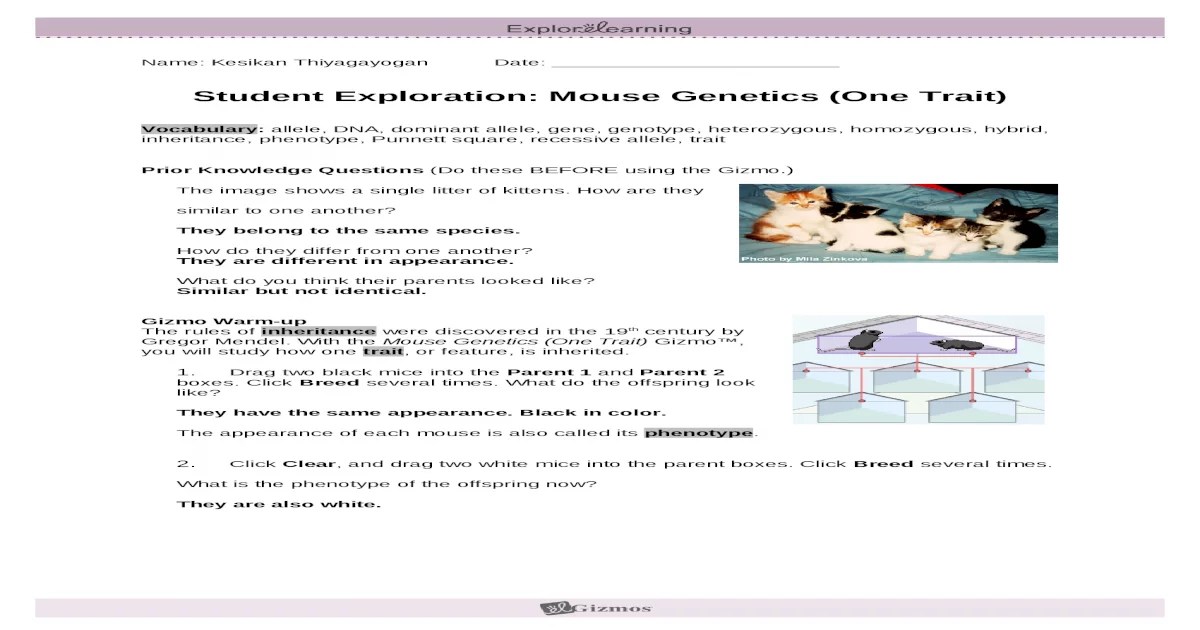Student exploration mouse genetics two traits delves into the captivating world of scientific inquiry, where the study of mouse genetics serves as a cornerstone for understanding the intricate mechanisms of inheritance. This exploration embarks on an educational journey to unravel the complexities of genetic traits, delving into the fascinating realm of Mendelian principles and their application in unraveling the genetic tapestry of mice.
Through meticulously designed experiments and rigorous data analysis, students embark on a quest to decipher the patterns of inheritance for two distinct traits, uncovering the secrets hidden within the genetic code. This immersive experience fosters a deep understanding of the fundamental concepts of genetics, nurturing a passion for scientific discovery and paving the path for future scientific endeavors.
1. Introduction

Mouse genetics has played a pivotal role in scientific research and education. Mice serve as model organisms due to their short generation time, well-characterized genetic background, and susceptibility to a wide range of genetic manipulations. Studying mouse genetics allows researchers to investigate fundamental biological processes, such as development, behavior, and disease pathogenesis.
Student exploration in mouse genetics is essential for fostering an understanding of genetic principles and their applications in biomedical research. By investigating two traits in mouse genetics, students can gain insights into the complex interactions between genes and the environment, as well as the inheritance patterns of different traits.
2. Experimental Design
An experiment to investigate two traits in mouse genetics involves the following steps:
- Variables:Identify the two traits of interest and define the independent and dependent variables.
- Controls:Establish control groups to account for environmental factors and genetic background.
- Procedures:Cross mice with different genotypes, collect genetic data (e.g., DNA samples), and perform statistical analysis.
Ethical considerations:Animal research must adhere to ethical guidelines to ensure the welfare and humane treatment of animals.
3. Data Analysis, Student exploration mouse genetics two traits
Data analysis in mouse genetics involves:
- Genetic data collection:Genotyping mice using techniques such as PCR and sequencing.
- Statistical analysis:Applying statistical methods (e.g., chi-square tests, ANOVA) to determine the inheritance patterns of the two traits.
Challenges and limitations:Data analysis in mouse genetics can be complex due to genetic heterogeneity and environmental influences.
4. Interpretation of Results
Interpreting results in mouse genetics involves:
- Genetic models:Proposing genetic models to explain the inheritance patterns of the two traits (e.g., Mendelian inheritance, polygenic inheritance).
- Evidence:Evaluating the evidence supporting or refuting each genetic model based on the experimental data.
- Implications:Discussing the implications of the findings for understanding mouse genetics and its applications in biomedical research.
5. Communication of Findings
Communicating findings in mouse genetics is crucial for:
- Data presentation:Designing tables to present the genetic data collected from the experiment.
- Poster or presentation:Creating a poster or presentation to communicate the findings of the investigation in a clear and concise manner.
- Importance of communication:Effectively communicating scientific research findings is essential for advancing knowledge and fostering collaboration.
FAQ Explained: Student Exploration Mouse Genetics Two Traits
What is the significance of mouse genetics in scientific research?
Mouse genetics plays a crucial role in scientific research, serving as a model organism for studying human diseases and genetic disorders. Mice share a high degree of genetic similarity with humans, making them ideal for investigating the genetic basis of complex traits and diseases.
Why is it important to investigate two traits in mouse genetics?
Investigating two traits in mouse genetics allows researchers to study the interactions between different genes and their effects on the phenotype. By examining the inheritance patterns of multiple traits, scientists can gain insights into the genetic architecture of complex traits and identify the genetic variants that contribute to disease susceptibility.
What are the challenges and limitations of data analysis in mouse genetics?
Data analysis in mouse genetics presents several challenges, including the large volume of data generated, the need for sophisticated statistical methods to analyze complex inheritance patterns, and the potential for confounding factors that can influence the results. Additionally, ethical considerations related to animal research must be carefully addressed.